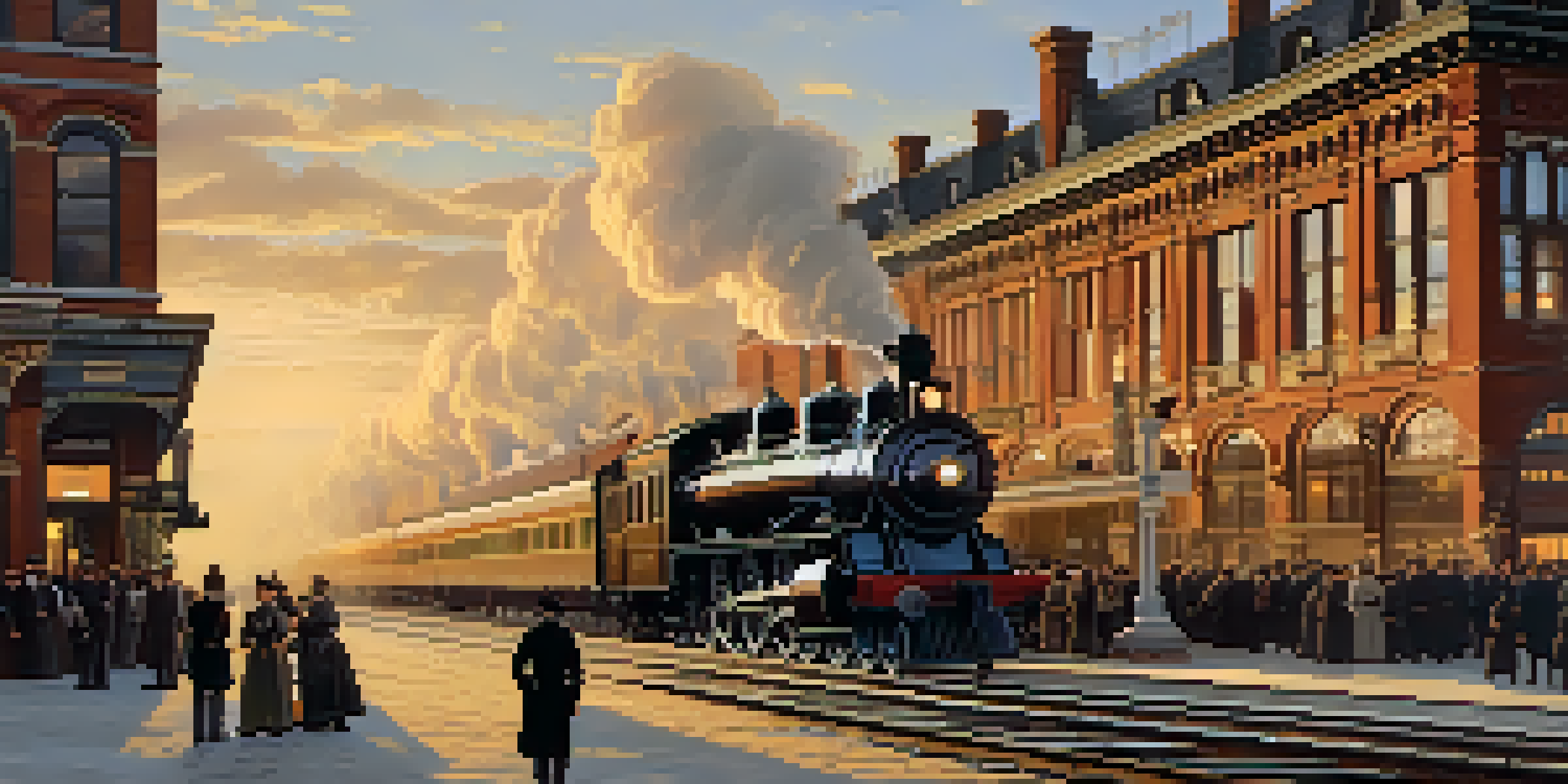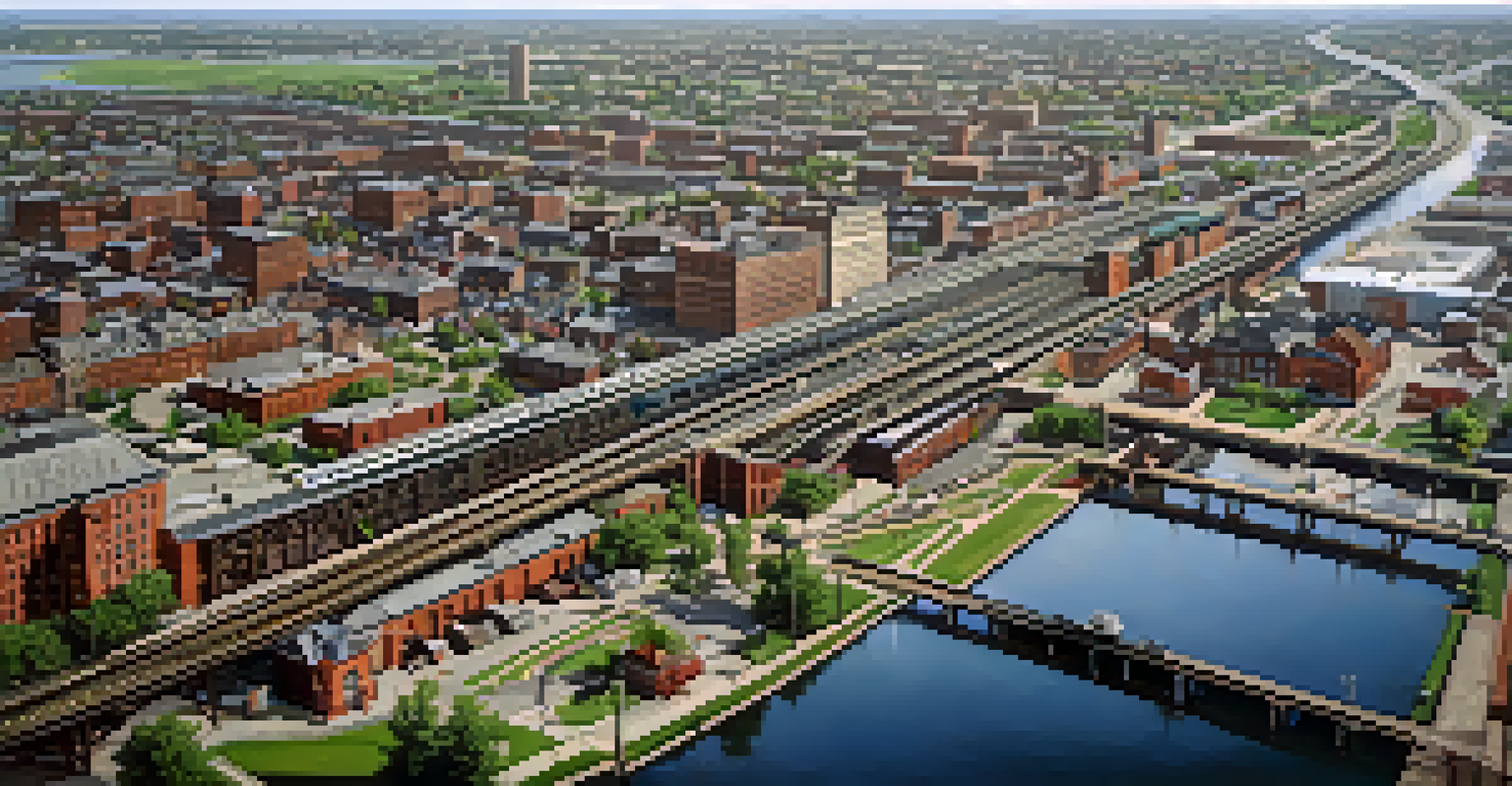The Role of Railways in Buffalo's Urban Development

The Historical Significance of Railways in Buffalo
Railways have played a pivotal role in shaping Buffalo's history since the 19th century. The city became a vital transportation hub due to its strategic location on Lake Erie, linking it to both the East Coast and the Midwest. This connectivity spurred economic growth and attracted industries, leading to a population boom that transformed Buffalo into a bustling metropolis.
The railway is a great social instrument. It brings people together, it integrates communities, and it creates opportunities for all.
As railroads expanded, they facilitated the movement of goods and people, making Buffalo an essential point for trade. The Erie Canal, which opened in 1825, complemented the rail system, allowing for even greater efficiency in transporting raw materials and finished products. This synergy between railways and canals helped establish Buffalo as a key player in the industrial revolution.
The establishment of major rail lines like the New York Central and the Pennsylvania Railroad further solidified Buffalo's reputation as a transportation center. This growth not only enhanced the economy but also shaped the city's landscape, leading to the development of neighborhoods and infrastructure that catered to the influx of workers and their families.
Railways and Urban Expansion in Buffalo
As railways connected Buffalo to various regions, they also spurred urban expansion. The ease of transport made it feasible for people to live further from their workplaces, leading to the growth of suburbs. These suburbs flourished as communities, with schools, parks, and shopping districts emerging to support the growing population.

Moreover, the railroads played a crucial role in the development of commercial areas within the city. Warehouses and factories sprang up near rail lines, creating jobs and attracting more residents. This industrial growth led to a vibrant urban environment, where businesses thrived, and the city's economy diversified.
Railways Fueled Buffalo's Growth
The expansion of railways in Buffalo during the 19th century transformed the city into a vital transportation hub, driving economic growth and urban development.
The influence of railways on urban planning is still evident today. Many of the neighborhoods and commercial districts established during this expansion phase remain integral to Buffalo's identity, showcasing a blend of historical architecture and modern developments.
Economic Impact of Railways on Buffalo
The economic impact of railways in Buffalo cannot be overstated. They facilitated the movement of agricultural products from the surrounding regions to markets, boosting the local economy. This access to transportation allowed businesses to flourish, leading to increased job opportunities for Buffalo's residents.
Transportation is the center of the economy. It brings together resources and people, resulting in growth and development.
In addition, the railways attracted various industries, including steel, grain, and manufacturing. This industrial diversification not only strengthened Buffalo's economy but also provided a stable source of income for many families. The growth of these industries was closely tied to the efficiency provided by rail transport.
As a result, Buffalo became known as the 'City of No Illusions,' reflecting its robust economic landscape. The wealth generated from these industries contributed to the development of infrastructure, education, and cultural institutions, further enhancing the city's appeal and quality of life.
Railways and Social Change in Buffalo
Railways not only transformed Buffalo's economy but also played a significant role in social change. They provided greater access to education and employment opportunities, particularly for immigrants who flocked to the city seeking a better life. This influx of diverse populations enriched the cultural fabric of Buffalo.
The accessibility of rail transport also allowed for the exchange of ideas and cultures, contributing to a vibrant community. Social organizations, cultural events, and recreational activities thrived as people from different backgrounds came together, fostering a sense of unity and collaboration.
Social Changes Driven by Railways
Railways enhanced access to education and employment, fostering cultural diversity and community engagement among Buffalo's residents.
Moreover, the railways offered residents the chance to travel beyond Buffalo, expanding their horizons. This newfound mobility encouraged exploration and appreciation of the broader region, enhancing Buffalo's reputation as a cosmopolitan city and encouraging a progressive mindset.
The Decline of Railways and Its Consequences
As the mid-20th century approached, the rise of automobiles and highways began to overshadow the railways. This shift led to a decline in rail traffic and the eventual closing of many rail lines in Buffalo, affecting both the economy and urban development. The loss of efficient transportation options resulted in job losses and economic stagnation.
With fewer trains in operation, Buffalo's once-thriving industrial sectors faced challenges. Many businesses reliant on rail transport struggled to adapt, leading to a noticeable decrease in economic activity. This decline contributed to urban blight, as neighborhoods lost their vibrancy and industries moved away.
Consequently, Buffalo faced significant challenges in revitalizing its urban landscape. The city had to seek alternative methods to promote economic growth, leading to initiatives aimed at repurposing former railway sites and investing in public transportation as part of a broader urban renewal strategy.
Revitalization Efforts in Buffalo’s Railway Areas
In recent years, Buffalo has made concerted efforts to revitalize areas once dominated by railways. Initiatives have focused on repurposing old railway lines into multi-use trails, fostering community engagement and promoting sustainable transportation. These efforts have not only enhanced recreational opportunities but also spurred economic development in adjacent neighborhoods.
Moreover, the conversion of former railway properties into mixed-use developments has breathed new life into the city. These projects often blend residential, commercial, and green spaces, creating vibrant communities that attract residents and businesses alike. This transformation reflects a growing trend towards urban living and sustainability.
Revitalization Efforts for Rail Areas
Recent initiatives in Buffalo focus on repurposing old railway lines and improving public transportation to boost economic development and sustainability.
Additionally, Buffalo's commitment to improving public transportation has been paramount in addressing the decline of railways. By investing in bus and light rail services, the city aims to provide residents with reliable commuting options while also reducing traffic congestion and environmental impact.
The Future of Railways in Buffalo
Looking ahead, the role of railways in Buffalo's urban development remains a topic of interest. There is a growing recognition of the need for efficient transportation systems to support sustainable growth. As cities increasingly focus on reducing their carbon footprint, there is potential for railways to play a crucial role in the future of urban mobility.
Innovative projects, such as high-speed rail connections and improved freight services, are being discussed to enhance Buffalo's connectivity. These initiatives could not only boost the local economy but also position Buffalo as a vital transportation hub in the region once again.

Ultimately, the future of railways in Buffalo will depend on collaboration between city planners, transportation authorities, and the community. By leveraging the lessons learned from the past, Buffalo can harness the power of railways to create a more interconnected, vibrant, and sustainable urban landscape.